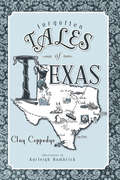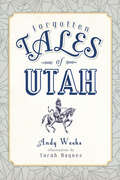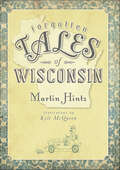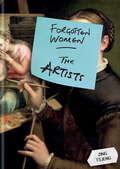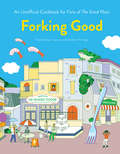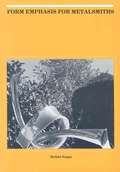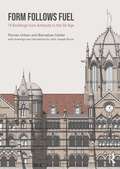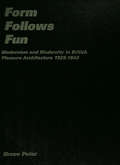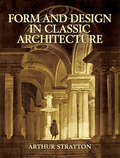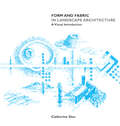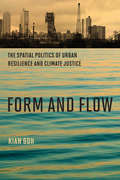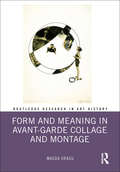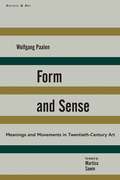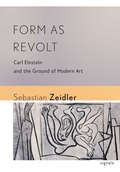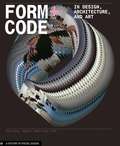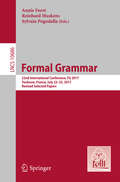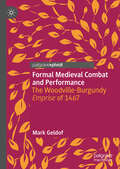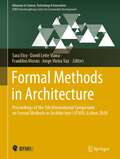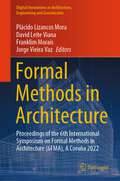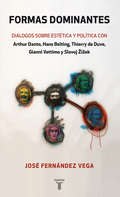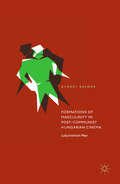- Table View
- List View
Forgotten Tales of Texas (Forgotten Tales)
by Clay CoppedgeFrom El Chupacabra to the Marx Brothers, Clay Coppedge has a talent for digging into Texas's most unusual history. Strange as they may seem, many of these Texas-sized legends are surprisingly true, like Pancho Villa's film contract and the notorious Crash at Crush, a staged train collision and failed publicity stunt that turned tragic outside of Katy. Whether fact or lore, each tale is irrefutably part of a unique and fascinating heritage that invigorates the spirit like a Texas frontier remedy.
Forgotten Tales of Utah (Forgotten Tales)
by Andy WeeksCharacters ranging from Mormon pioneers to Butch Cassidy all helped give the Beehive State color and tenacity. Uncover the state’s hidden gems with stories like the first group of Latter-day Saints who arrived in the Salt Lake Valley days before Brigham Young proclaimed it as “the right place.” Meet an ancient prophet believed to have walked the arid landscape, offering his blessing on several sites long before the pioneers arrived. Learn why a former lawyer was buried without a proper headstone. Discover the state’s quirky side with the strange goings-on at an obscure ranch and the alleged monsters once believed to haunt some of Utah’s lakes. Author Andy Weeks offers this quirky and informative collection of little-known tales about the forty-fifth state.
Forgotten Tales of Wisconsin (Forgotten Tales)
by Martin HintzDrift back to an era when the speed limit in Milwaukee was an edgy four miles per hour and Madison lawmakers could poke at hogs to punctuate the tedium of legislative sessions. Martin Hintz makes even the slow times of the Badger State fly by in this collection of Wisconsin's forgotten memories. Taste the world's first batch of pink lemonade (made with the dye of a circus performer's pants) and witness the tragic death of the world's last wild passenger pigeon. Track down ancient Algonkin legends like the great serpent that swam up the Mississippi looking for copper, and drop in on modern legends like Les Paul, whose guitar spun records into gold.
Forgotten Women: The Artists (Forgotten Women Ser.)
by Zing Tsjeng'To say this series is "empowering" doesn't do it justice. Buy a copy for your daughters, sisters, mums, aunts and nieces - just make sure you buy a copy for your sons, brothers, dads, uncles and nephews, too.' - IndependentThe women who shaped and were erased from our history.Forgotten Women is a new series of books that uncover the lost herstories of influential women who have refused over hundreds of years to accept the hand they've been dealt and, as a result, have formed, shaped and changed the course of our futures. From leaders and scientists to artists and writers, the fascinating stories of these women that time forgot are now celebrated, putting their achievements firmly back on the map.The Artists brings together the stories of 48* brilliant woman artists who made huge yet unacknowledged contributions to the history of art, including Camille Claudel, the extraordinarily talented sculptor who was always unfairly overshadowed by her lover, Rodin; Baroness Elsa von Freytag-Loringhoven, who has been claimed as the true originator of Marcel Duchamp's Fountain; and Ana Mendieta, the Cuban refugee who approached violence against women through her performance art before her own untimely death. With chapters ranging from Figurative to Photography, and Craft to Conceptual, this is an alternative guide to art history that demonstrates the broad range of artistic movements that included, and were often pioneered by, female artists who have been largely overlooked.*The number of Nobel-prize-winning women.
Forgotten Women: The Artists (Forgotten Women)
by Zing Tsjeng'To say this series is "empowering" doesn't do it justice. Buy a copy for your daughters, sisters, mums, aunts and nieces - just make sure you buy a copy for your sons, brothers, dads, uncles and nephews, too.' - IndependentThe women who shaped and were erased from our history.Forgotten Women is a new series of books that uncover the lost herstories of influential women who have refused over hundreds of years to accept the hand they've been dealt and, as a result, have formed, shaped and changed the course of our futures.The Artists brings together the stories of 48* brilliant woman artists who made huge yet unacknowledged contributions to the history of art, including Camille Claudel, the extraordinarily talented sculptor who was always unfairly overshadowed by her lover, Rodin; Baroness Elsa von Freytag-Loringhoven, who has been claimed as the true originator of Marcel Duchamp's Fountain; and Ana Mendieta, the Cuban refugee who approached violence against women through her performance art before her own untimely death. With chapters ranging from Figurative to Photography, and Craft to Conceptual, this is an alternative guide to art history that demonstrates the broad range of artistic movements that included, and were often pioneered by, female artists who have been largely overlooked.*The number of Nobel-prize-winning women.
Forking Good: An Unofficial Cookbook for Fans of The Good Place
by Stephen H. Segal Valya Dudycz LupescuFor fans of NBC's The Good Place, a pun-filled and fully illustrated cookbook of 30 original recipes inspired by the philosophy and food humor of the hit show.With its high concept, exceptional writing, eye-popping set design, stellar cast, meaningful explorations of what it means to be a good person, and clam chowder fountains, The Good Place has captured the hearts and minds of critics and viewers alike.For the first time ever, fans can indulge their cravings for The Good Place with delicious, comforting, original recipes like “Macaroni and Socra-cheese,” “I Think Therefore I Clam (Chowder),” “I Kant Believe It’s Not Buttermilk Pancakes,” and more. Each recipe title references a philosopher or philosophical concept from the show and uses food analogies to explain those concepts to readers who, like Eleanor, can’t always follow Chidi’s lectures.A refreshing and entertaining twist on cookbooks, Forking Good will help you plan your next viewing party as you re-binge your favorite show.
Form Emphasis For Metalsmiths
by Heikki SeppaRedefines the vocabulary of metalsmithing. In print for more than three decades. A master artist and teacher of metalwork presents a bold new approach to creative expression in metal. Believing that the time has come for the artist to free himself from the functional forms that have dominated the metal smith's craft--the cup, the box, the pitcher, etc.--Heikki Seppa urges the craftsman to create in terms of pure form, and in this book he shows him how. Two Things are essential. The first is a thorough understanding of the special properties of metal as an artistic medium and an intimate knowledge of techniques for working it. Only when he has mastered the physical means of working with metal can the artist free his imagination for unimpeded creation. Though not addressed to the beginner, Seppa discusses the fundamental techniques of planishing, soldering, and hinging--all the basic means by which metal is shaped. The second is to free the artist from thinking in terms of function, since this limits his concepts of what can be created. Even such traditional forms as the cube, the cone, the cylinder, and the dome have their limitations, and Seppa opens new possibilities by creating a new vocabulary, new terms by which to identify the many shapes metal can take under skilled hands. A major feature of this book is an extensive glossary of these terms, each one illustrated with a sketch by the author. The book is profusely illustrated throughout with the author's own sketches of the ideas and techniques discussed. It will be of significant value to the accomplished craftsman as well as to teachers and advanced students of this exciting and growing art form. The artistic metal creations of Heikki Seppa have won international acclaim, from his award of master status in silversmithing from the Ministry of Education in his native Finland to numerous exhibits and awards here and abroad. As a teacher of metalsmithing in the School of Fine Arts of Washington University, Mr. Seppa's work with young artists led to the formulation of the new approach to creativity in metal that he details in this book.
Form Follows Finance: Skyscrapers and Skylines in New York and Chicago
by Carol WillisAlthough fundamental factors of program, technology, and economics make tall buildings everywhere take similar forms, skyscrapers in New York and Chicago developed very differently in the first half of the twentieth century. <p><p>In contrast to standard histories that counterpose the design philosophies of the Chicago and New York "schools," Willis shows how market formulas produced characteristic forms in each city—"vernaculars of capitalism"—that resulted from local land-use patterns, municipal codes, and zoning. Refuting some common clich s of skyscraper history such as the equation of big buildings with big business and the idea of a "corporate skyline," Willis emphasizes the importance of speculative development and the impact of real-estate cycles on the forms of buildings and on their spatial distribution.
Form Follows Fuel: 14 Buildings from Antiquity to the Oil Age
by Barnabas Calder Florian UrbanModernists believed that “form follows function.” Form Follows Fuel shows that in fact energy has been the biggest influence on the world’s architecture throughout the history of our species. The availability of energy under different fuel regimes – including human labour, firewood, coal, oil, gas, and renewables – shapes architecture at all scales, from what gets built to how its doors hinge.This book is the first to quantify energy inputs for a range of buildings worldwide and across the historical record. In the process, it challenges today's architects, offers practical solutions to today's ecological crises, and highlights the aspects of today’s buildings that make architecture responsible for 37% of human climate-changing emissions. It reveals the enormously lower impacts of historical alternatives to today’s default building practices.This book shows that the shift to modern fossil fuel use, from the seventeenth century, came to be the most consequential move in the history of architecture as well as in human history in general. This brought about remarkable wealth for the built environment and at the same time unprecedented dangers for our planet, as evidenced by the exacerbating climate emergency.This book consists of 14 accessibly written case studies, illustrated with beautiful and revealing new measured drawings of each project by John Joseph Burns. Each chapter focuses on a single structure in a particular historical context, sometimes contrasted to similar buildings, from subsistence farming to advanced global capitalism. The chapters analyse the consumption of embodied and operational energy in these buildings, and also discuss questions of recycling and adaptive reuse. They complement precise descriptions with hard numbers on materials and construction, using robustly sourced approximations where exact figures are not available. The case studies rely on both published research and the authors’ own calculations and allow systematic comparison across different global regions and historical periods.Cases include architectural icons such as the Great Pyramid of Giza, the Baths of Caracalla, the Mausoleum of Qin Shi Huang, the Seagram Building, and Terminal 1 of Kuala Lumpur International Airport, as well as common types such as a pre-modern stone house, a late-nineteenth-century tenement, and a modernist panel block. Examples are taken from different regions of the world, including ancient China, pre-Columbian Mexico, and modern Europe. This book is an important contribution to architectural historical research, written for students, academics and building professionals as well as for a general audience.
Form Follows Fun: Modernism and Modernity in British Pleasure Architecture 1925–1940
by Bruce PeterAuthoritative and readable, this excellent text, illustrated by a unique pictorial record of period architecture, surveys and examines how and why the architecture of pleasure related to the stylistic and ideological concerns of modernism in 1930s Britain. Responding to the current interest in modernism and packed with a substantial archive of high quality photographs and other documentation, it relates the professional, entrepreneurial and institutional infrastructures affecting the pleasure industry’s architectural development and appearance in 1930s. A broad range of building through which the general public first experienced Modernism are covered, including: commercial – holiday camps, cinemas and greyhound racing stadia municipal and governmental projects – zoos, seaside pavilions, concert halls, and imperial and international exhibitions. Arguing that the responses to modernism through the architecture of pleasure were conditioned by wider debates about the role of design in relation to high and mass culture, this book is an ideal resource for all those interested in architectural history and design in Britain between the wars.
Form and Design in Classic Architecture
by Arthur StrattonMost people recognize at a glance the extraordinarily graceful proportions of classical-style buildings such as London's Syon House and Athenaeum Club and the Banqueting Hall at Whitehall. Few, however, appreciate the underlying geometrical principles that lend these buildings their elegant unity of expression. Form and Design in Classic Architecture explains in simple, direct terms -- and with numerous photographic plates and line illustrations -- the ways in which the relationship of exterior and interior elements creates that unity and sense of completeness.Dozens of edifices by Inigo Jones, the Adam Brothers, Sir Christopher Wren, and other renowned architects appear here, in images accompanied by detailed analyses. The author presents a chapter-by-chapter view of buildings in a variety of shapes, with separate treatments of vestibules, corridors, domed and vaulted ceilings, pavilions, loggias, interior and exterior staircases, porticoes, and colonnades.The informative, readable text and handsome illustrations -- as well as the sheer beauty of the buildings themselves -- make this volume appealing, not only to architects and architectural historians but also to anyone with even a casual interest in architecture and design.
Form and Fabric in Landscape Architecture: A Visual Introduction
by Catherine DeeForm and Fabric in Landscape Architecture provides an original, visual approach to the study of landscape architecture by creating a spatial morphology based on use and experience of landscapes. It explores aesthetic, spatial and experiential concepts by providing a structure through which landscapes can be understood and conceived in design. 'Fabric' is the integrated structure of whole landscapes, while 'form' refers to the components that make up this fabric. Together form and fabric create a morphology of landscape useful for the development of visual-spatial design thinking and awareness. This book is intended as both an introduction to the discipline for students of landscape architecture, architecture and planning, and a source of continuing interest for more experienced environmental designers.
Form and Fabric in Landscape Architecture: A Visual Introduction
by Catherine DeeForm and Fabric in Landscape Architecture provides an original, visual approach to the study of landscape architecture by creating a spatial morphology based on use and experience of landscapes. It explores aesthetic, spatial and experiential concepts by providing a structure through which landscapes can be understood and conceived in design. 'Fabric' is the integrated structure of whole landscapes, while 'form' refers to the components that make up this fabric. Together form and fabric create a morphology of landscape useful for the development of visual-spatial design thinking and awareness. This book is intended as both an introduction to the discipline for students of landscape architecture, architecture and planning, and a source of continuing interest for more experienced environmental designers.
Form and Flow: The Spatial Politics of Urban Resilience and Climate Justice (Urban and Industrial Environments)
by Kian GohAn examination of urban climate change response strategies and the resistance to them by grassroots activists and social movements.Cities around the world are formulating plans to respond to climate change and adapt to its impact. Often, marginalized urban residents resist these plans, offering &“counterplans&” to protest unjust and exclusionary actions. In this book, Kian Goh examines climate change response strategies in three cities—New York, Jakarta, and Rotterdam—and the mobilization of community groups to fight the perceived injustices and oversights of these plans. Looking through the lenses of urban design and socioecological spatial politics, Goh reveals how contested visions of the future city are produced and gain power. Goh describes, on the one hand, a growing global network of urban environmental planning organizations intertwined with capitalist urban development, and, on the other, social movements that themselves often harness the power of networks. She explores such initiatives as Rebuild By Design in New York, the Giant Sea Wall plan in Jakarta, and Rotterdam Climate Proof, and discovers competing narratives, including community resiliency in Brooklyn and grassroots activism in the informal &“kampungs&” of Jakarta. Drawing on participatory fieldwork and her own background in architecture and urban design, Goh offers both theoretical explanations and practical planning and design strategies. She reframes the critical concerns of urban climate change responses, presenting a sociospatial typology of urban adaptation and considering the notion of a &“just&” resilience. Finally, she proposes a theoretical framework for designing equitable and just urban climate futures.
Form and Forces
by Edward Allen Waclaw ZalewskiHere, in one volume, is all the architect needs to know to participate in the entire process of designing structures. Emphasizing bestselling author Edward Allen's graphical approach, the book enables you to quickly determine the desired form of a building or other structure and easily design it without the need for complex mathematics. This unique text teaches the whole process of structural design for architects, including selection of suitable materials, finding a suitable configuration, finding forces and size members, designing appropriate connections, and proposing a feasible method of erection. Chapters are centered on the design of a whole structure, from conception through construction planning.
Form and Meaning in Avant-Garde Collage and Montage (Routledge Research in Art History)
by Magda DraguThis book uses intermedial theories to study collage and montage, tracing the transformation of visual collage into photomontage in the early avant-garde period. Magda Dragu distinguishes between the concepts of collage and montage, as defined across several media (fine arts, literature, music, film, photography), based on the type of artistic meaning they generate, rather than the mechanical procedures involved. The book applies theories of intermediality to collage and montage, which is crucial for understanding collage as a form of cultural production. Throughout, the author considers the political implications, as collages and montages were often used for propagandistic purposes. This book combines research methods used in several areas of inquiry: art history, literary criticism, analytical philosophy, musicology, and aesthetics.
Form and Sense
by Deborah Rosenthal Wolfgang Paalen Martica SawinWolfgang Paalen was a central figure in internationalist surrealist circles in the late 1930s. Artist and intellectual, he was a European whose fascination with archaic cultures led him finally to Mexico, where he founded the influential magazine DYN in 1941. In the bold texts from DYN that make up Form and Sense, we encounter a unique artistic mind and an oracular voice.Paalen's book is an intellectual delight with essays on cubism, surrealism, the universality of forms in architecture, and the relationships that exist between art and science. He weaves together the new ideas and archaic inspirations in twentieth-century painting and sculpture. His nuanced and original considerations of some key figures--Mondrian, Kandinsky, Picasso--marked Paalen in turn as a significant thinker in the world of modern art.This painter's book, illustrated with carefully chosen examples of the art he examines, makes us not only understand but also experience the rich interplay between idea and image that informs the art of our own time. A new introduction by the scholar Martica Sawin examines Paalen's career, particularly his influential writing on surrealism and abstraction.
Form as Revolt: Carl Einstein and the Ground of Modern Art
by Sebastian ZeidlerThe German writer and art critic Carl Einstein (1885-1940) has long been acknowledged as an important figure in the history of modern art, and yet he is often sidelined as an enigma. In Form as Revolt Sebastian Zeidler recovers Einstein's multifaceted career, offering the first comprehensive intellectual biography of Einstein in English. Einstein first emerged as a writer of experimental prose through his involvement with the anarchist journal Die Aktion. After a few limited forays into art criticism, he burst onto the art scene in 1915 with his book Negro Sculpture, at once a formalist intervention into the contemporary theory and practice of European sculpture and a manifesto for the sophistication of African art. Einstein would go on to publish seminal texts on the cubist paintings of Georges Braque and Pablo Picasso. His contributions to the surrealist magazine Documents (which Einstein cofounded with Georges Bataille), including writings on Picasso and Paul Klee, remain unsurpassed in their depth and complexity. In a series of close visual analyses--illustrated with major works by Braque, Picasso, and Klee--Zeidler retrieves the theoretical resources that Einstein brought to bear on their art. Form as Revolt shows us that to rediscover Einstein's art criticism is to see the work of great modernist artists anew through the eyes of one of the most gifted left-wing formalists of the twentieth century.
Form+Code: In Design, Art, And Architecture
by Casey Reas Lust Chandler McWilliams Jeroen BarendseThe last decade has witnessed a proliferation of artists whose primary medium is software. Algorithmic processes, harnessed through the medium of computer code, allow artists to generate increasingly complex visual forms that they otherwise might not have been able to imagine, let alone delineate. The newest volume in our Design Brief series Form+Code in Design, Art, and Architecture is a non-technical introduction to the history, theory, and practice of software in the arts. Organized into themes linked to aspects of code—repetition, transformation,parameters, visualization, and simulation—each of the book's sections contains an essay, code samples, and numerous illustrations.
Formal Grammar: 22nd International Conference, FG 2017, Toulouse, France, July 22-23, 2017, Revised Selected Papers (Lecture Notes in Computer Science #10686)
by Annie Foret Reinhard Muskens Sylvain PogodallaEdited in collaboration with FoLLI, the Association of Logic, Language and Information, this book constitutes the refereed proceedings of the 22nd International Conference on Formal Grammar, FG 2017, collocated with the European Summer School in Logic, Language and Information in July 2017. The 9 contributed papers were carefully reviewed and selected from 14 submissions.The focus of papers are as follows: Formal and computational phonology, morphology, syntax, semantics and pragmatics Model-theoretic and proof-theoretic methods in linguistics Logical aspects of linguistic structure Constraint-based and resource-sensitive approaches to grammar Learnability of formal grammar Integration of stochastic and symbolic models of grammar Foundational, methodological and architectural issues in grammar and linguistics Mathematical foundations of statistical approaches to linguistic analysis
Formal Medieval Combat and Performance: The Woodville-Burgundy Emprise of 1467
by Mark GeldofThis book collects together all contemporary and near-contemporary accounts of the 1467 emprise, a particular performative feat of arms, between Anthony Woodville, Lord Scales—brother of Elizabeth Woodville, wife of King Edward IV of England—and Antoine, &‘Grand Bastard of Burgundy,&’ natural son of Duke Philip &‘the Good&’ of Burgundy. Held at Smithfield, London, this emprise has long interested historians of chivalry because of the detailed accounts of its organization and the commentaries on the combats held over two days. Despite its familiarity to readers of late medieval English and European history, the accounts themselves have not historically been easily accessible, and several of them have never appeared in translation in English before now. This collection gathers those accounts, presents them in readable English editions, and gives historical contexts for their content.
Formal Methods in Architecture: Proceedings of the 5th International Symposium on Formal Methods in Architecture (5FMA), Lisbon 2020 (Advances in Science, Technology & Innovation)
by Sara Eloy David Leite Viana Franklim Morais Jorge Vieira VazThis edited book gathers research studies presented at the 5th International Symposium on Formal Methods in Architecture (5FMA), Lisbon 2020. Studies focus on the use of methodologies, especially those that have witnessed recent developments, that stem from the mathematical and computer sciences and are developed in a collaborative way with architecture and related fields. This book constitutes a contribution to the debate and to the introduction of new methodologies and tools in the mentioned fields that derive from the application of formal methods in the creation of new explicit languages for problem-solving in architecture and urbanism. It adds valuable insight into the development of new practices solving identified societal problems and promoting the digital transformation of institutions in the mentioned fields. The primary audience of this book will be from the fields of architecture, urban planning, civil engineering, AEC, landscape design, computer sciences and mathematics, both academicians and professionals.
Formal Methods in Architecture: Proceedings of the 6th International Symposium on Formal Methods in Architecture (6FMA), A Coruña 2022 (Digital Innovations in Architecture, Engineering and Construction)
by David Leite Viana Franklim Morais Jorge Vieira Vaz Plácido Lizancos MoraThis book comprises the select proceedings of the 6th International Symposium on Formal Methods in Architecture (6FMA), A Coruña 2022. The contents focus on the use of methodologies, especially those that have witnessed recent developments stemming from mathematical and computer sciences and are developed in a collaborative way with architecture and related fields. This book constitutes a contribution to the debate and to the introduction of new methodologies and tools in the mentioned fields that derive from the application of formal methods in the creation of new explicit languages for problem-solving in architecture and urbanism. Some of the themes in the book are CAD and BIM, mixed realities, photogrammetry and 3D scan, architectural design automation, urban and building performance analysis, SCAVA-space configuration, accessibility and visibility analysis. This book proves a valuable resource for those in academia and industry.
Formas dominantes: Diálogos sobre estética y política
by José Fernández VegaDiálogos sobre estética y política con Arthur Danto, Hans Belting, Thierry de Duve, Gianni Vattimo y Slavoj Zizek. Arthur C. Danto, Hans Belting, Thierry de Duve, Gianni Vattimo y Slavoj Zizek son cinco grandes exponentes del pensamiento contemporáneo provenientes de diferentes tradiciones intelectuales; todos ellos fueron entrevistados por José Fernández Vega en distintos momentos de la primera década del siglo XXI. El fruto de esas conversaciones es recogido en este libro, que aborda asuntos centrales para la estética y para la relación que en la actualidad el arte mantiene con la política. En algunos de estos diálogos el tema principal es la comprensión de la situación histórica del arte más reciente o los nuevos desafíos que enfrenta la teoría estética. En otros, la crítica filosófica de la actualidad, el análisis de la coyuntura social o las transformaciones culturales de nuestro tiempo. En todos los casos se trata de intercambios accesibles en los que no se elude la polémica. Formas dominantes nos brinda un panorama actual del arte y la cultura, una herramienta valiosa para reflexionar sobre nuestro presente histórico y la condición contemporánea a través de la mirada autorizada de unos intérpretes excepcionales.
Formations of Masculinity in Post-Communist Hungarian Cinema
by György KalmárThis book investigates the formations of masculinity in Hungarian cinema after the fall of communism and explores some of the cultural phenomena of the years following the 1989 regime change. The films explored offer a unique perspective encompassing two entirely different worlds: state socialism and neoliberal capitalism. The films suggest that Eastern Europe is somehow different than its western counterpart and that its subjects are marked by what they went through before and after 1989. These films are all remembering, interpreting, picturing, marketing and trying to come to terms with this difference—with the memory and effects of state-socialism. In looking closely at the films’ male figures, one may not only get a glimpse of the dramatic changes Eastern European societies went through after the fall of communism but also see the brave new world of global neoliberal capitalism through the eyes of the Eastern European newcomers.
